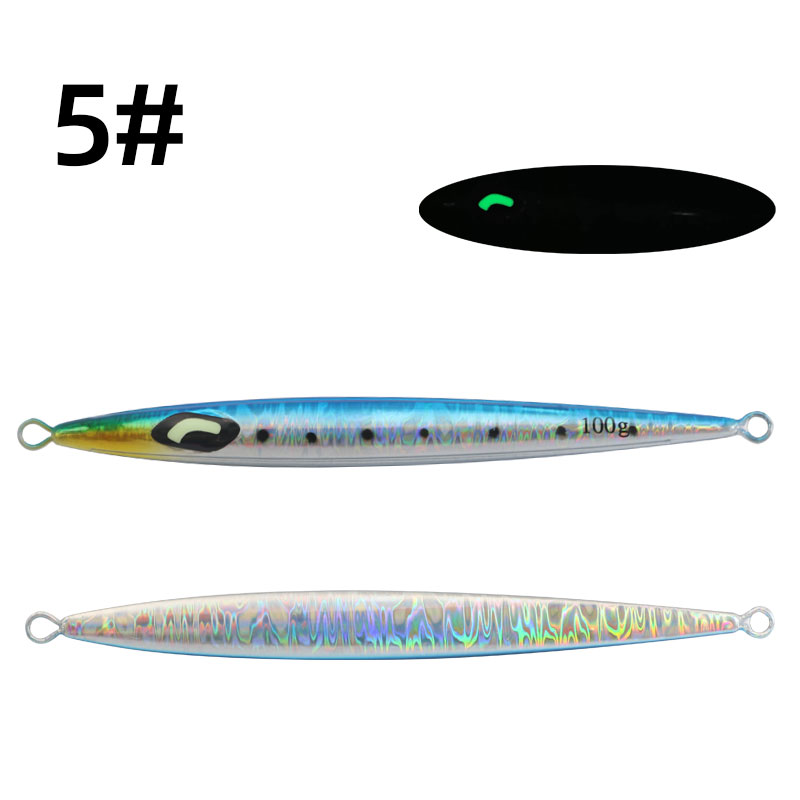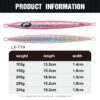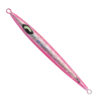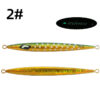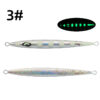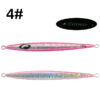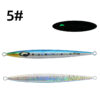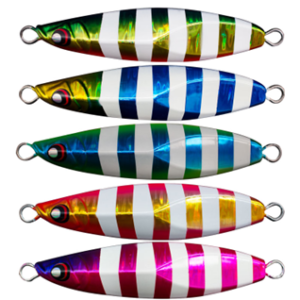Metal Jig Fishing Lure Slow Cast Jigging Spoon colorful Artificial Shore Metal Bait Sea Tackle
Fishing enthusiasts know that the right lure can make all the difference when it comes to landing that prized catch. Among the various types of fishing lures, metal jigs have gained immense popularity for their versatility and effectiveness in attracting a wide range of fish species. In this article, we’ll explore what metal jig lures are, how to use them effectively, and tips to maximize your fishing success.
Детали
| Color | optional |
|---|---|
| Material | Lead, metal |
| Weight | 100g,150g,200g,250g,300g |
| Model | TX-19 |
| Package | PVC Bag |
Product Details:
Metal jig fishing is one of the most effective and versatile methods for catching fish, whether you’re in freshwater or saltwater. Known for their speed, durability, and action that mimics distressed baitfish, metal jigs are an essential part of any angler’s toolkit. Whether you’re targeting big predators in the deep sea or casting around structure for bass, metal jigs offer unmatched flexibility and success rates. In this comprehensive guide, we’ll explore everything you need to know about metal jig fishing, from selecting the right gear to mastering advanced techniques that will take your fishing to the next level.
Why Metal Jigs Are Essential for Every Angler
The popularity of metal jigs is not just because of their wide variety of applications, but also due to the unique advantages they offer:
- Effective for Different Species: Metal jigs attract both pelagic species like tuna, kingfish, and mahi-mahi, as well as bottom-feeding species such as snapper, grouper, and cod. Their versatility allows you to target a wide range of fish with a single tool.
- Fast Sinking Speed: Metal jigs are heavy and sink quickly, which is perfect for deep-sea fishing and situations where you need to reach fish at lower depths, such as around wrecks, reefs, and structures.
- Realistic Flutter Action: The design of metal jigs mimics the movement of wounded or fleeing baitfish. Their action attracts fish by imitating the exact erratic movements of prey in distress.
- Durability and Longevity: Unlike soft plastics, metal jigs are resistant to wear and tear. They hold up against repeated strikes, underwater obstacles, and tough fishing conditions, making them a long-lasting investment.
- Versatile Retrieval Techniques: Whether you’re slow-pitch jigging for bottom feeders or high-speed jigging for fast swimmers, metal jigs allow you to experiment with different techniques to find what works best in any given scenario.
How to Choose the Right Metal Jig for Your Fishing Adventure
The right metal jig can make or break your fishing trip. Here are the key factors to consider when selecting a jig:
- Weight: The weight of your metal jig affects how fast it sinks and how well it performs in different currents. Heavier jigs (100g and up) are perfect for deep-water fishing or areas with strong currents, while lighter jigs (20g–60g) are ideal for shallow waters or when targeting species near the surface.
- Shape and Profile:
- Slim, long jigs: These jigs sink faster and are better for quick retrieves.
- Flat or wide jigs: These are ideal for slow-pitch jigging, providing a wide flutter as they sink, which mimics a fish in distress.
- Curve-sided jigs: These tend to have a more erratic action, ideal for fast-moving fish like tuna.
- Color: Fish are attracted to jigs that match their natural prey, but color choice can also depend on water clarity and time of day:
- Bright or reflective colors: Ideal for clear waters to simulate shiny, healthy baitfish.
- Glow-in-the-dark or UV colors: Best for low-light conditions, like early morning or night fishing, or murky water.
- Hook Size and Quality: Most metal jigs come with a built-in hook or assist hooks, but the quality of the hook matters. For larger fish, ensure you use strong, sharp hooks that can handle the pressure. High-quality assist hooks will ensure better hook sets and fewer missed strikes.
Mastering Metal Jigging Techniques: From Beginner to Pro
There are several jigging techniques, each suited to different fish species and water conditions. Here’s how to master them:
- Vertical Jigging:
- How it works: Drop the jig straight down and jig it up and down, creating a vertical motion in the water.
- When to use: Ideal for deep-water fishing, especially when targeting bottom-dwelling species like grouper or snapper.
- Pro tip: Vary the speed and motion of your jig to see what gets the best response. Fast jerks often work for aggressive fish, while slower movements are great for bottom feeders.
- High-Speed Jigging:
- How it works: Retrieve the jig quickly with short, sharp jerks. This mimics the erratic movement of a baitfish trying to escape.
- When to use: Ideal for pelagic species like tuna, kingfish, and amberjack, which are aggressive and hunt fast-moving prey.
- Pro tip: Use a braided line with high sensitivity to detect subtle bites during high-speed retrieval.
- Slow-Pitch Jigging:
- How it works: The jig is slowly dropped to the desired depth, and a series of slow, deliberate jerks create a fluttering, lifelike action.
- When to use: Perfect for bottom-feeding species like halibut or snapper, as they tend to strike more slowly.
- Pro tip: Focus on slow, rhythmic motions that keep the jig in the strike zone longer. This technique requires patience but is often very rewarding.
- Casting and Retrieving:
- How it works: Cast the jig and retrieve it with a consistent pace, adding pauses and subtle twitches to imitate a distressed fish.
- When to use: This technique works well in shallow water or when fishing around structures, such as rocks or reefs, where fish may be hiding.
- Pro tip: Experiment with different speeds and pauses to match the mood of the fish.
- Long Drop:
- How it works: Allow the jig to sink slowly and naturally to simulate a struggling or injured baitfish.
- When to use: This is useful when fish are hesitant or less active, often in deeper waters or colder months.
- Pro tip: Let the jig fall all the way to the bottom, then retrieve it slowly, keeping the jig in the strike zone for longer.
Where to Fish with Metal Jigs
Knowing where to fish with metal jigs is as important as using the right technique. Here are the best places to use metal jigs:
- Reefs and Wrecks: Fish love to congregate around structures such as reefs and shipwrecks, which offer hiding spots and abundant food. Drop a metal jig near these structures and jig it in the vicinity for the best chance at a strike.
- Deep-Sea Fishing: Metal jigs excel in deep waters, where their weight helps them sink quickly and stay in the strike zone longer. Whether you’re targeting deep-sea species or working the bottom for cod and halibut, metal jigs can reach depths other lures can’t.
- Open Water for Pelagic Fish: When fishing in open water for fast-swimming species like tuna or mahi-mahi, metal jigs are highly effective. Their sleek, shiny design mimics the movement of baitfish, making them irresistible to hungry predators.
- Strong Current Areas: Metal jigs perform well in areas with fast-moving currents, where lighter lures would be swept away. Their weight keeps them in place, allowing for effective jigging and better fish control.
- Shallow Water: Even in shallow water, metal jigs can be used effectively by varying the retrieve speed. Use lighter jigs in these areas to achieve a slower flutter action that draws in more cautious fish, like bass or trout.
Pro Tips for Improving Your Metal Jig Fishing
- Use High-Sensitivity Gear: Metal jigging often requires you to feel the fish’s bite or detect subtle movements. Using high-sensitivity rods and braided line can help you detect bites, even in deep water or at high speeds.
- Experiment with Retrieve Speeds: Don’t stick to one speed—vary your retrieval and jerking technique until you find what works best for the fish on that particular day. Sometimes a fast, erratic retrieve will do the trick, while at other times, a slow, steady motion is more effective.
- Match the Local Baitfish: Fish are more likely to strike at a jig that closely resembles their natural prey. Observe the local baitfish species in the area and select a jig that matches both in size and color to increase your chances of success.
- Watch for Slack Line: When you feel a sudden slack in your line, it often means a fish has struck. Set the hook immediately to increase your chances of a solid hook-up.
- Adjust to Water Conditions: Water conditions like clarity, temperature, and current speed affect how fish will react to a jig. Be flexible with your jig’s size, weight, and color depending on the time of day, water conditions, and target species.
- Practice Patience: Metal jigging can be a waiting game. Allow the jig to drop slowly and stay in the strike zone. Be patient and keep experimenting with your technique until you hook a fish.
Заключение
Metal jig fishing is a versatile and effective method for catching a wide range of species, from pelagic giants like tuna to bottom-dwelling favorites like snapper. By choosing the right jig, understanding when and where to fish, and mastering advanced jigging techniques, you can increase your chances of landing a big catch. The key to successful metal jig fishing lies in experimenting with techniques, adapting to changing conditions, and having the patience to let the jig do its work. With the tips and advice







